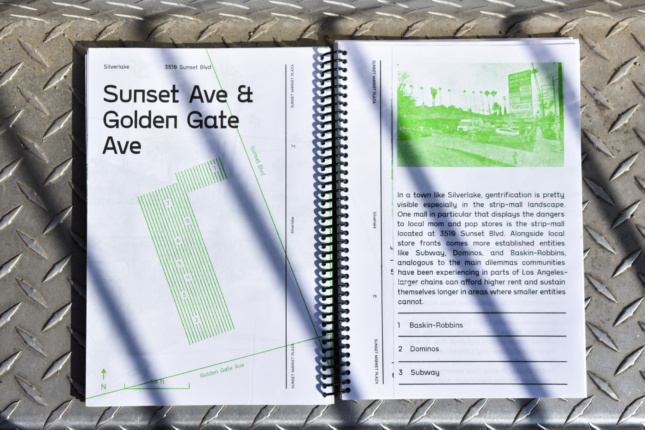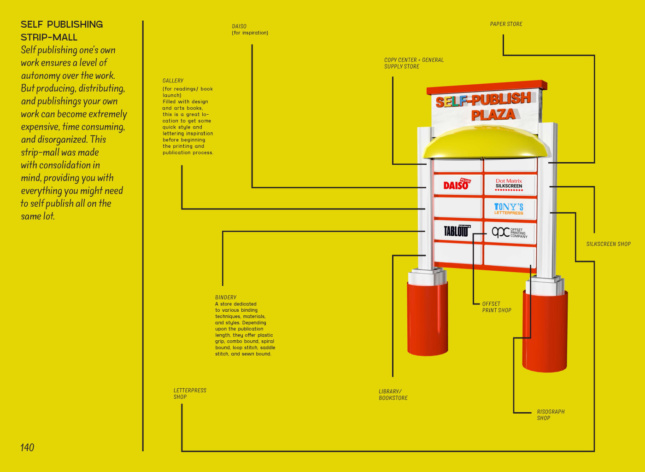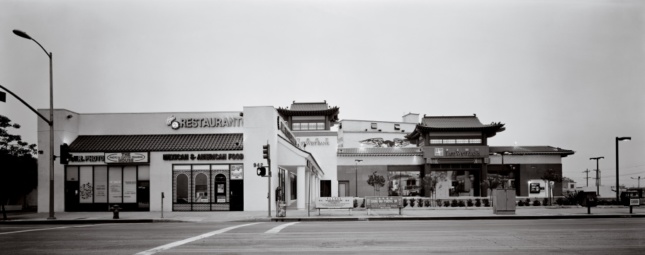Sunset Market Plaza: Meditations on Strip Malls in Los Angeles
Edited by Shaina Goel and Use All Five
Published by Use All Five
List Price: $35.00
If there was ever an official tribunal to determine what Architecture is and what it is not, the strip mall building type might be placed in the latter category without hesitation. Strip malls, sometimes known as mini-malls, can rarely be traced back to an architect, virtually never receive historic protections, and are rarely perceived as anything more than a response to the modern consumer’s demand for convenience. Even their origins struggle to align with any familiar canons of architecture history: when the 1972 oil crisis caused several gas stations to close throughout Los Angeles, their small corner parcels became ideal sites for the inexpensively-constructed building type, which attracted small business owners due to their relatively cheap rental costs.

A new self-published book by the Los Angeles-based design firm Use All Five and edited by Shaina Goel intends to elevate the strip-mall into a building type as worthy of study as any other, complete with a historical overview, fine-art photography, and genuine speculations concerning its future against the prevalence of online shopping. Sunset Market Plaza: Meditations on Strip Malls in Los Angeles begins with a plea for clemency from Robert Venturi, Denise Scott Brown, and Steven Izenour’s 1972 classic Learning from Las Vegas: “Learning from the existing landscape is a way of being revolutionary for an architect. Not the obvious way, which is to tear down Paris and begin again, as Le Corbusier suggested in the 1920s. But another, more tolerant way; that is, to question how we look at things.” Just as the two saw the common person’s tastes made legitimate in Sin City, so too does the team behind Sunset Market Plaza elaborate on its subject without a hint of irony or derision. Its spiral-bound spine and numerous fold-outs, in fact, lend it the essence of a field guide.
The first half of the book details several of the “best strip malls in L.A.” and nearby San Gabriel Valley, each distinguished by their site plans rendered in dense green stripes and the businesses they contain. Comparing plans, it becomes clear that the strip mall is an infinitely variable thing: some are more than one story, some are irregularly shaped, some have scores of underground parking and many have surprising relationships to the street(s) in front of them. Reading through their descriptions tells us that many of the businesses have not only survived for decades but have also become some of the most popular destinations in the city for a variety of cuisines and specialty services.

Sunset Market Plaza also includes a few proposals for the future (or alternate past) of the strip mall, in response to the highly informed marketing present in the world of online shopping. “What would happen,” its editors ask, “if these strip malls were designed with more explicit intentionality?” The results, as they imagine them, are “made with consolidation in mind.” One proposal imagines a strip mall as a one-stop-shop for self-publishing, with independent shops that, when combined, would become a graphic designer’s paradise, while another, titled “Wedding Chapel Plaza” divides the space into several independent businesses catering to the wedding crowd. It becomes up to the reader to determine whether these spaces function better with all of its spaces united under one industry or, more traditionally, as divided among many independently-spirited businesses.

An interview between urban planner Jonathan Crisman and urban developer Sam Bachner, the “key figure in the history of strip malls because of his role in co-founding La Mancha Development Company,” succinctly reveals the thought process behind their unique aesthetics. When asked about his approach towards the architecture and design of strip malls, Bachner claimed that he has always aspired “to incorporate elements which are reflective of the specific community in which they are located… Some places might care more about color schemes, or I might have one place with a bell tower, or maybe I will use a blue tile roof in Koreatown—it’s all about community context.” Near the end of Sunset Market Plaza are Catherine Opie’s panoramic photos of strip malls across Los Angeles, all of which honorably confirm the site-specificity Bachner describes as well as their delicate beauty. “[Strip malls] are about the American dream for me,” writes Opie. “But they’re very fragile. They change almost overnight, and are often forgotten about, just like the freeways.”











